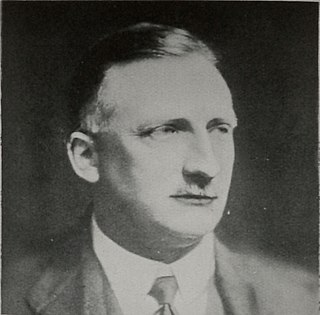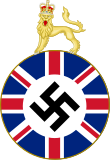
The British Union of Fascists (BUF) was a British fascist political party formed in 1932 by Oswald Mosley. Mosley changed its name to the British Union of Fascists and National Socialists in 1936 and, in 1937, to the British Union. In 1939, following the start of the Second World War, the party was proscribed by the British government and in 1940 it was disbanded.

Arnold Spencer Leese was a British fascist politician. Leese was initially prominent as a veterinary expert on camels. A virulent anti-Semite, he led his own fascist movement, the Imperial Fascist League, and was a prolific author and publisher of polemics both before and after the Second World War.
The National Fascisti (NF), renamed British National Fascists (BNF) in July 1926, were a splinter group from the British Fascisti formed in 1924. In the early days of the British Fascisti the movement lacked any real policy or direction and so this group split away with the intention of pursuing a more definite path towards a fascist state. The group had 60 members at its creation, and around 500 at its height.

The National Socialist League (NSL) was a short-lived Nazi political movement in the United Kingdom immediately prior to the Second World War.

John Warburton Beckett was a British politician who was a Labour Party MP from 1924 to 1931. During the 1930s, he joined the fascist movement, first in the British Union of Fascists and later as a founder of the National Socialist League. During World War II, he was interned in Britain.
The Nordic League (NL) was a far-right organisation in the United Kingdom from 1935 to 1939 that sought to serve as a co-ordinating body for the various extremist movements whilst also seeking to promote Nazism. The League was a private organisation that did not organise any public events.

Rotha Beryl Lintorn Lintorn-Orman was the founder of the British Fascisti, the first avowedly fascist movement to appear in British politics.

Edward Jeffrey Hamm was a leading British fascist and supporter of Oswald Mosley. Although a minor figure in Mosley's prewar British Union of Fascists, Hamm became a leading figure after the Second World War and eventually succeeded as leader of the Union Movement after Mosley's retirement.

Alexander Raven Thomson, usually referred to as Raven, was a Scottish politician and philosopher. He joined the British Union of Fascists in 1933 and remained a follower of Oswald Mosley for the rest of his life. Thomson was considered to be the party's chief ideologue and has been described as the "Alfred Rosenberg of British fascism".
The British People's Party (BPP) was a British far-right political party founded in 1939 and led by ex-British Union of Fascists (BUF) member and Labour Party Member of Parliament John Beckett.
The British Brothers' League (BBL) was a British anti-immigration, extraparliamentary, pressure group, the "largest and best organised" of its time. Described as proto-fascist, the group attempted to organise along paramilitary lines.
Robert Forgan was a British politician who was a close associate of Oswald Mosley.

Robert Byron Drury Blakeney, generally known as R. B. D. Blakeney, was a British Army officer and fascist politician. After a career with the Royal Engineers, Blakeney went on to serve as President of the British Fascists.

Lieutenant-Colonel Graham Seton Hutchison was a British First World War army officer, military theorist, author of both adventure novels and non-fiction works and fascist activist. Seton Hutchison became a celebrated figure in military circles for his tactical innovations during the First World War but would later become associated with a series of fringe fascist movements which failed to capture much support even by the standards of the far right in Britain in the interbellum period. He made a contribution to First World War fiction with his espionage novel, The W Plan.
British fascism is the form of fascism which is promoted by some political parties and movements in the United Kingdom. It is based on British ultranationalism and imperialism and had aspects of Italian fascism and Nazism both before and after World War II.
Neil Lanfear Maclean Francis Hawkins was a British writer and politician who was a leading proponent of British fascism in the United Kingdom both before and after the Second World War. He played a leading role in the British Union of Fascists and controlled the organisational structure of the movement.

The British Fascists was the first political organisation in the United Kingdom to claim the label of fascism, formed in 1923. The group had little ideological unity apart from anti-socialism for much of its existence, and was strongly associated with British conservatism. William Joyce, Neil Francis Hawkins, Maxwell Knight and Arnold Leese were amongst those to have passed through the movement as members and activists.
Henry Maxence Cavendish Drummond Wolff, commonly known as Henry Drummond Wolff, was a British Conservative Party politician. Drummond Wolff was known for his close ties to the far right.
The Militant Christian Patriots (MCP) were a short-lived but influential anti-Semitic organisation active in the United Kingdom immediately prior to the Second World War. It played a central role in the ultimately unsuccessful attempts to keep the UK out of any European war.











